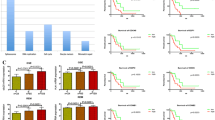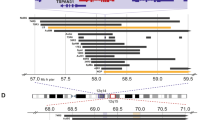Abstract
The decoy receptor 3 (DcR3) gene is amplified at high frequency in human lung, colon, and liver cancers. DcR3 has been demonstrated to produce a secreted member of the tumor necrosis factor receptor superfamily that negatively regulates Fas-mediated apoptosis. In this study we examined DcR3 gene amplification, DcR3 mRNA expression, and DcR3 protein expression in 46 human astrocytic brain tumors by quantitative genomic PCR, quantitative reverse transcription-PCR, and immunohistochemistry, respectively. The DcR3 gene amplification was detected in none of 6 (0%) low-grade astrocytomas, 1 of 16 (6%) anaplastic astrocytomas, and 6 of 24 ( 25%) glioblastomas. Six of 7 (86%) cases with gene amplification exhibited both mRNA overexpression and/or protein overexpression, suggesting that DcR3 mRNA and protein were expressed more abundantly in the cases with gene amplification. We thus concluded that high DcR3 mRNA expression and protein expression may be positively related to the gene amplification in astrocytic brain tumors, especially glioblastomas. Further, we speculated that the DcR3 gene amplification with overexpression may be responsible for malignant features in glioblastomas.

Similar content being viewed by others
References
Bai C, Connolly B, Metzker ML, Hilliard CA, Liu X, Sandig V, Soderman A, Galloway SM, Liu Q, Austin CP, Caskey TC (2000) Overexpression of M68/DcR3 in human gastrointestinal tract tumors independent of gene amplification and its location in a four-gene cluster. Proc Natl Acad Sci USA 97:1230–1235
Biernat W, Kleihues P, Yonekawa Y, Ohgaki H (1997) Amplification and overexpression of MDM2 in primary (de novo) glioblastomas. J Neuropathol Exp Neurol 56:180–185
Fults D, Brockmeyer D, Tullous MW, Pedone CA, Cawthon RM (1992) p53 mutation and loss of heterozygosity on chromosome 17 and 10 during human astrocytoma progression. Cancer Res 52:674–679
Gibson UE, Heid CA, Williams PM (1996) A novel method for real time quantitative RT-PCR. Genome Res 6:995–1001
He J, Allen JR, Collins VP, Allalunis-Turner MJ, Godbout R, Day RS 3rd, James CD (1994) CDK4 amplification is an alternative mechanism to p16 gene homozygous deletion in gliomas cell lines. Cancer Res 54:5804–5807
Kleihues P, Louis DN, Scheithauer BW, Rorke LB, Reifenberger G, Burger PC, Cavenee WK (2002) The WHO classification of tumors of the nervous system. J Neuropathol Exp Neurol 61:215–225
Lengauer C, Kinzler KW, Vogelstein B (1998) Genetic instabilities in human cancers. Nature 396:643–649
Louis DN (1997) A molecular genetic model of astrocytoma histopathology. Brain Pathol 7:755–764
Nishizaki T, Ozaki S, Harada K, Ito H, Arai H, Beppu T, Sasaki K (1998) Investigation of genetic alteration associated with the grade of astrocytic tumor by comparative genomic hybridization. Genes Chromosomes Cancer 21:340–346
Pitti RM, Marsters SA, Lawrence DA, Roy M, Kischkel FC, Dowd P, Huang A, Donahue CJ, Sherwood SW, Baldwin DT, Godowski PJ, Wood WI, Gurney AL, Hillan KJ, Cohen RL, Goddard AD, Botstein D, Ashkenazi A (1998) Genomic amplification of a decoy receptor for Fas ligand in lung and colon cancer. Nature 396:699–703
Rasheed BK, McLendon RE, Herndon JE, Friedman HS, Friedman AH, Bigner DD, Bigner SH (1994) Alterations of the TP53 gene in human gliomas. Cancer Res 54:1324–1330
Reifenberger G, Liu L, Ichimura K, Schmidt EE, Collins VP (1993) Amplification and overexpression of the MDM2 gene in a subset of human malignant gliomas without p53 mutations. Cancer Res 53:2736–2739
Reifenberger G, Reifenberger J, Ichimura K, Meltzer PS, Collins VP (1994) Amplification of multiple genes from chromosomal region 12q13–14 in human malignant gliomas: preliminary mapping of the amplicons shows preferential involvement of CDK4, SAS, and MDM2. Cancer Res 54:4299–4303
Roth W, Isenmann S, Nakamura M, Platten M, Wick W, Kleihues P, Bahr M, Ohgaki H, Ashkenazi A, Weller M (2001) Soluble decoy receptor 3 is expressed by malignant gliomas and suppresses CD95 ligand-induced apoptosis and chemotaxis. Cancer Res 61: 2759–2765
Von Deimling A, Ammon K von, Schoenfeld D, Wiestler OD, Seizinger BR, Louis DN (1993) Subsets of glioblastoma multiforme defined by molecular genetic analysis. Brain Pathol 3:19–26
Watanabe K, Tachibana O, Sata K, Yonekawa Y, Kleihues P, Ohgaki H (1996) Overexpression of the EGF receptor and p53 mutations are mutually exclusive in the evolution of primary and secondary glioblastomas. Brain Pathol 6:217–223
Wong AJ, Bigner SH, Bigner DD, Kinzler KW, Hamilton SR, Vogelstein B (1987). Increased expression of the epidermal growth factor receptor gene in malignant gliomas is invariably associated with gene amplification. Proc Natl Acad Sci USA 84:6899–6903
Wu Y, Han B, Sheng H, Lin M, Moore PA, Zhang J, Wu J (2003) Clinical significance of detecting elevated serum DcR3/TR6/M68 in malignant tumor patients. Int J Cancer 105:724–732
Yang CR, Hsieh SL, Teng CM, Ho FM, Su WL, Lin WW (2004) Soluble decoy receptor 3 induces angiogenesis by neutralization of TL1A, a cytokine belonging to tumor necrosis factor superfamily and exhibiting angiostatic action. Cancer Res 64:1122–1129
Acknowledgement
We are grateful to A. Imamura for her technical assistance.
Author information
Authors and Affiliations
Corresponding author
Rights and permissions
About this article
Cite this article
Arakawa, Y., Tachibana, O., Hasegawa, M. et al. Frequent gene amplification and overexpression of decoy receptor 3 in glioblastoma. Acta Neuropathol 109, 294–298 (2005). https://doi.org/10.1007/s00401-004-0956-6
Received:
Revised:
Accepted:
Published:
Issue Date:
DOI: https://doi.org/10.1007/s00401-004-0956-6




